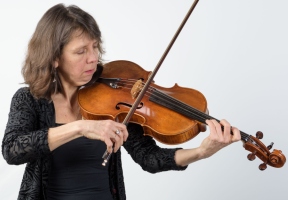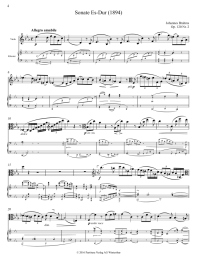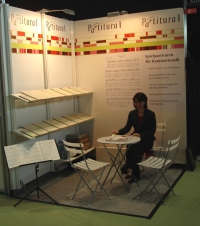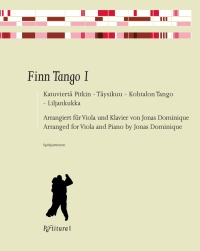
|
10 years of Partitura Verlag |
by Stephanie Gurtner, translated by: Sohpia Benedict
 Throughout my life as a musician, I have often returned to the question: why do pianists and singers have the full score in front of them, whilst I, as a viola player, must be content with a single stave? Are those who play a melody instrument, perhaps, already overstretched? Does the mastery of one's own instrument leave no room for a comprehensive overview during the rehearsal? Or do instrumental players automatically have so good a musical memory as to be able to see the entire score without notes? Very few are so fortunate. Or do the musicians simply care too little about what their partners are playing? That may well be the case occasionally, but cannot be the sole reason.
Throughout my life as a musician, I have often returned to the question: why do pianists and singers have the full score in front of them, whilst I, as a viola player, must be content with a single stave? Are those who play a melody instrument, perhaps, already overstretched? Does the mastery of one's own instrument leave no room for a comprehensive overview during the rehearsal? Or do instrumental players automatically have so good a musical memory as to be able to see the entire score without notes? Very few are so fortunate. Or do the musicians simply care too little about what their partners are playing? That may well be the case occasionally, but cannot be the sole reason.No. With painstaking craftmanship, musicians cut up study scores and glue the pieces onto oversized card. With the help of props on the music stand,
 many such scores are played. In addition to the instrument and the music stand, a large folder for the card has to be dragged along, as well as an iron to smoothen the folded card! Famous string quartets play from home-made scores. Speaking with colleagues, I realised that many of them wished to play from printed full scores. Why, then, do publishers shy away from publishing such scores?
many such scores are played. In addition to the instrument and the music stand, a large folder for the card has to be dragged along, as well as an iron to smoothen the folded card! Famous string quartets play from home-made scores. Speaking with colleagues, I realised that many of them wished to play from printed full scores. Why, then, do publishers shy away from publishing such scores?Ten years ago, I reached a crossroads in my life when an illness of my inner ear forced me to cut down on playing. I arrived at my decision almost automatically: now is the time to try out publishing full scores! From the beginning, our three person team consisted of our accomplished engraver Johannes Schlesinger, the experienced publisher Markus Neuenschwander, and me, viola player, long-time orchestra and chamber musician.
 At the beginning, we pondered over many questions: how small could the piano part be, in order for it to be seen? How would the page turns work? We soon realised that if the melody line has too few rests, we had a problem – because the page turns have to be manageable. Our prototype was the sonata in F minor op. 120 no 1 for viola and piano by Brahms, and it worked. And so began Partitura Verlag. In March 2007 we set up a small stand at the Frankfurter Musikmesse selling our first catalogue: eight sonatas with piano, three trios and a string quartet.
At the beginning, we pondered over many questions: how small could the piano part be, in order for it to be seen? How would the page turns work? We soon realised that if the melody line has too few rests, we had a problem – because the page turns have to be manageable. Our prototype was the sonata in F minor op. 120 no 1 for viola and piano by Brahms, and it worked. And so began Partitura Verlag. In March 2007 we set up a small stand at the Frankfurter Musikmesse selling our first catalogue: eight sonatas with piano, three trios and a string quartet.We were quickly met with lively interest, especially from performing musicians. "Brilliant! Can’t you publish all of Beethovan’s violin sonatas?” "When will the Bartok quartets come out?" "Oh, had this existed earlier, my life would have been different!" Above all, well-known viola teachers and viola soloists soon began to approach Partitura Verlag, namely Thomas Riebl, Kim
 Kashkashian and Roger Benedict. And so it rapidly developed into a specialized viola publishers. This, I feel, is not a coincidence: perhaps viola players react well to the new offer having gained a unique understanding of the complete score from their position in the middle of an orchestra or a quartet.
Kashkashian and Roger Benedict. And so it rapidly developed into a specialized viola publishers. This, I feel, is not a coincidence: perhaps viola players react well to the new offer having gained a unique understanding of the complete score from their position in the middle of an orchestra or a quartet.Nevertheless, sceptical voices were heard, especially from within dealer circles. Questioning whether it was really necessary, they decided mine was too small a clientele for such a niche product, and that it was too expensive to print sheet music in times of digitization. With the demand too small to support my livelihood, after a few years I faced a choice: obey the market and give up, or continue this labour of love at a professional standard in my own time. I chose the latter, and I am delighted to continue serving my small fan base, to be re-inspired by artists at international viola congresses and competitions, and to experience how much the Partitura editions are appreciated by my customers.
 In addition to original literature, our catalogue contains adaptations for viola and piano of violin works, as well as transcriptions of works for voice and piano. We also have solo pieces for viola, and virtuosic transcriptions of Spanish guitar music for solo viola. Our programme is enriched by transcriptions of Argentinian tangos and, a personal love of mine, tangos from Finland. The next planned edition contains both Argentine and Finnish tangos; look forward to the duos for two violas!
In addition to original literature, our catalogue contains adaptations for viola and piano of violin works, as well as transcriptions of works for voice and piano. We also have solo pieces for viola, and virtuosic transcriptions of Spanish guitar music for solo viola. Our programme is enriched by transcriptions of Argentinian tangos and, a personal love of mine, tangos from Finland. The next planned edition contains both Argentine and Finnish tangos; look forward to the duos for two violas!Partitura Publishing Website: www.partitura-verlag.com
Review Brahms in «The Orchestra»: www.dasorchester.de
Partitura on Facebook: www.facebook.com/Partitura-VerlagScores of Partitura in our Onlineshop
» Finn Tango I
» Finn Tango II
» Johannes Brahms - Sonate f-minor, op. 120, Nr. 1
» Johannes Brahms - Sonate Eb-major op. 120, Nr. 2
edson wrote on 11.05.2019 at 10:02
Steffi - greetings! I still have your audition tape for Budapest! You have not changed very much I think! Edson - edsonpike@hotmail.com
| Blog overview |
» To the blog list
| Newsletter |
 Do you don't want to miss any news regarding viola anymore? Our newsletter will keep you informed.
Do you don't want to miss any news regarding viola anymore? Our newsletter will keep you informed.» Subscribe to our Newsletter for free
 Visit us on Facebook. The news articles are also posted.
Visit us on Facebook. The news articles are also posted.» To Facebook